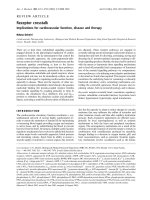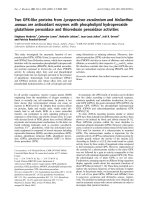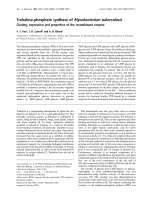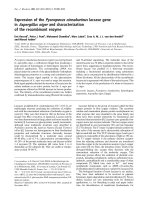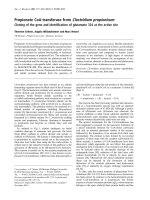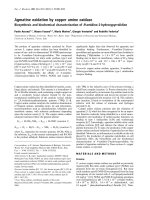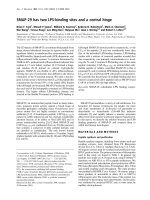Báo cáo Y học: Brassica napus soluble epoxide hydrolase (BNSEH1) Cloning and characterization of the recombinant enzyme expressed in Pichia pastoris docx
Bạn đang xem bản rút gọn của tài liệu. Xem và tải ngay bản đầy đủ của tài liệu tại đây (347.99 KB, 8 trang )
Brassica napus
soluble epoxide hydrolase (BNSEH1)
Cloning and characterization of the recombinant enzyme expressed in
Pichia pastoris
Stefan Bellevik
1
, Jiaming Zhang
2
and Johan Meijer
1
1
Department of Plant Biology, Genetics Center, Swedish University of Agricultural Sciences, Uppsala, Sweden;
2
National
Biotechnology Laboratory of Tropical Crops, Chinese, Academy of Tropical Agricultural Sciences, Chengxi, Haikou, China
Epoxide hydrolase (EC 3.3.2.3) in plants is involved in the
metabolism of epoxy fatty acids and in mediating defence
responses. We report the cloning of a full-length epoxide
hydrolase cDNA (BNSEH1) from oilseed rape (Brassica
napus) obtained by screening of a cDNA library prepared
from methyl jasmonate induced leaf tissue, and the 5¢-RACE
technique. The cDNA encodes a soluble protein containing
318 amino acid residues. The identity on the protein level is
85% to an Arabidopsis soluble epoxide hydrolase (sEH) and
50–60% to sEHs cloned from other plants. A 5 · His tag
was added to the N-terminus of the BNSEH1 and the con-
struct was over-expressed in the yeast Pichia pastoris. The
recombinant protein was recovered at high levels after
Ni-agarose chromatography of lysed cell extracts, had a
molecular mass of 37 kDa on SDS/PAGE and cross-reacted
on Western blots with antibodies raised to a sEH from
Arabidopsis thaliana. BNSEH1 was shown to be a monomer
by gel filtration analysis. The activity was low towards cis-
stilbene oxide but much higher using trans-stilbene oxide as
substrate with V
max
of 0.47 lmolÆminÆmg
)1
, K
m
of 11 l
M
and k
cat
of 0.3 s
)1
. The optimum temperature of the
recombinant enzyme was 55 °C and the optimum pH 6–7
for trans-stilbene oxide hydrolysis. The isolation of
BNSEH1 will facilitate metabolic engineering of epoxy fatty
acid metabolism for functional studies of resistance and seed
oil modification in this important oilcrop.
Keywords: epoxide hydrolase, oilseed rape, yeast, recom-
binant enzyme, stilbene oxide.
Epoxide hydrolases [1] are hydrolytic enzymes that have
been found in mammals, plants, yeast, fungi, insects and
bacteria. In mammals several forms exist with a heteroge-
neous tissue distribution of which microsomal and soluble
(sEH) epoxide hydrolases have been most extensively
studied. These enzymes differ from each other in several
aspects such as substrate preference, turnover rate, sensitiv-
ity to inhibitors, pH optimum, etc. [2]. Several geometrically
different but related epoxides such as cis-stilbene oxide
(CSO) and trans-stilbene oxide (TSO) have been found to be
useful substrates in order to distinguish soluble from
membrane bound epoxide hydrolases [3,4]. These substrate
pairs can be applied to crude extracts to assess the relative
contribution of membrane bound and soluble forms to the
total epoxide hydrolase activity in many species.
Based on sequence homology analysis epoxide hydrolase
was classified as a member of a super family of hydrolytic
enzymes including esterases and lipases, united by an a/b
hydrolase fold and a similar catalytic triad motif [5]. The
three-dimensional structure of epoxide hydrolase has been
resolved for mouse [6], fungal [7] and bacterial enzymes [8].
These studies have confirmed the predicted a/b fold struc-
ture, provided a detailed picture of the active site and
proposed a mechanism of the catalytic reaction supported by
site-directed mutagenesis. Epoxide hydrolases act through a
two-step mechanism in which an acidic nucleophile attacks
the epoxide ring, forming a covalent intermediate, which is
then hydrolysed by a polarized water molecule [9].
Epoxide hydrolases in mammals are essential in the
detoxification of epoxides that are toxic due to the
electrophilic and unstable nature of the epoxide ring [2].
The relevance of this enzyme for detoxification in plants is
uncertain, however. Certain plants store epoxy fatty acids in
seeds, e.g. Euphorbia lagascae contains up to 60% epoxy
fatty acids in the seed oil [10]. Epoxide hydrolase is probably
needed for complete b-oxidation of epoxy fatty acids, e.g.
during germination when seed stores are broken down prior
to photosynthetic growth. However, epoxide hydrolases are
also present in plants low in epoxy fatty acids and have been
cloned from several species such as potato [11], soybean
[12,13], Arabidopsis [14] and Euphorbia [15]. No microsomal
epoxide hydrolase has been cloned from plants as yet, which
indicates that this form is not necessary or that sEH may
have a broader role in general.
Engineering of epoxide hydrolase in a crop such as oilseed
rape allows for agricultural and industrial applications.
Polymers of epoxy and hydroxy fatty acids are important
constituents of the cutin layer and serve as a protective
barrier against stress [16]. Certain epoxy and hydroxy fatty
acids have fungicidal activity in rice [17] and mediate defence
responses in infected potato tubers [18]. Modulation of
Correspondence to S. Bellevik, Department of Plant Biology,
Genetics Center, Box 7080, Swedish University of Agricultural
ScI
`
ences, SE-750 07 Uppsala, Sweden.
Fax: + 46 18 673279, Tel.: + 46 18 673320,
E-mail:
Abbreviations: BNSEH1, soluble epoxide hydrolase 1 from Brassica
napus;CSO,cis-stilbene oxide; MeJa, methyl jasmonate; sEH, soluble
epoxide hydrolase; TSO, trans-stilbene oxide.
Enzymes: epoxide hydrolase (EC 3.3.2.3).
(Received 26 June 2002, revised 27 August 2002,
accepted 10 September 2002)
Eur. J. Biochem. 269, 5295–5302 (2002) Ó FEBS 2002 doi:10.1046/j.1432-1033.2002.03247.x
epoxide hydrolase expression may thus be used to improve
crop protection. Another possibility is the use of B. napus as
a host to generate high amounts of epoxy or hydroxy fatty
acids in the seed for production of technical oils or plastics
[19]. Successful engineering has already altered seed fatty acid
composition to create high laurate [20] and up-regulated
palmitate, stearate and c-linolenate (x-6) B. napus lines [21].
Several genes encoding sEH exist in potato, soybean and
Arabidopsis [11,13,22] and apparently also in oilseed rape
(S. Bellevik, J. Lin & J. Meier). Enzymatic characterization
is necessary to better understand the functional roles of the
isoforms and in this study we have used the yeast P. pastoris
as host for over-expression of the first sEH cloned from
B. napus (BNSEH1). We here present data concerning the
physico-chemical and biochemical properties of the recom-
binant enzyme.
EXPERIMENTAL PROCEDURES
Materials
Oligonucleotides were purchased from TAGC (Copenha-
gen, Denmark). All enzymes were purchased from MBI
Fermentas (Vilnius, Lithuania) unless stated otherwise.
CSO and TSO (Aldrich Chemical Co., Milwaukee, WI,
USA); b-naphtoflavone, sodium-parahydroxymercuri
benzoate, quercitin (3,3¢,4¢,5,7-pentahydroxyflanone) (Sigma
Chemical Co., St Louis, MO); chalcone oxide (Lancaster
Synthesis, Morecambe, UK); x-bromo-4-nitroacetophe-
none (Fluka AG; Buchs, Switzerland); 1-ethyl-3-(3-dimethyl-
aminopropyl) carbodiimide (Bio-Rad Laboratories, Hemel
Hempstead, UK); N,N¢-dicyclohexylcarbodiimide (kind gift
of A
˚
ke Engstro
¨
m, Uppsala University); dimethylsulfoxide
(Merck AG, Darmstadt, Germany); tetrahydrofurane
(Riedel-de-Ha
¨
en, Seelze, Germany) were purchased from
the sources indicated. N,N¢-dicyclohexylcarbodiimide was
hydrolysed at 37 °C for 16 h to form the corresponding
urea (N,N¢-dicyclohexylurea) derivative [23].
Cloning of
B. napus
sEH
One partial B. napus sEH cDNA clone (BNSEH1) was
isolated by hybridization screening of a reamplified (oli-
godT)-primed cDNA library prepared from rapeseed leaves
exposed to methyl jasmonate (MeJa) for 5 h (Clontech,
Palo Alto, CA, USA) using a heterologous EST clone
(#140O6t7, Arabidopsis Ohio Stock Center) as a probe. This
EST corresponds to an earlier described Arabidopsis epo-
xide hydrolase cDNA (AtsEH1) [14] but also contains
intron sequences (S. Bellevik & J. Meier). BB4 was used as
bacterial host strain in the hybridization screening and XL1-
Blue for conversion to pBluescript. The probe was random-
primed using [
32
P]dCTP (Amersham International, Bucks,
England), purified by gel filtration and used at 10
6
c.p.m.ÆmL
)1
. Hybridization was performed at high strin-
gency conditions using Hybond N
+
nylon filters (Amer-
sham Biosciences, Uppsala, Sweden) according to the
manufacturer’s instructions. Signals were detected after
36–56 h exposure on Biomax MS X-ray films (Amersham
Biosciences). One of the positive phage clones was excised
from Lambda Zap II using R408 helper phage coinfection
but was found to lack the initial bases of the 5¢-end
(including the initiating methionine codon).
5¢-Rapid amplification of cDNA ends (RACE)
ASMART
TM
RACE cDNA Amplification kit (Clontech)
was employed to amplify the missing 5¢-region of the
cDNA. Total RNA from young B. napus cv. Hanna
seedlings were isolated after grinding in liquid nitrogen
using phenol/chloroform extraction and precipitation with
lithium chloride. Several RACE PCR products correspond-
ing to the cDNA clone were obtained using one nested
primer pair after the first cDNA synthesis. In the first strand
synthesis Superscript II
TM
Rnase H
–
Reverse Transcriptase
(Life Technologies, Ta
¨
by, Sweden) was used with the
RACE kit. The first PCR was performed with the Advant-
age 2 Polymerase Mix supplied using the Universal Primer
Mix and a gene specific primer (5¢ AGG ACC GAA AGA
GAA AGG AAC AGA 3¢) by cycling for 35 cycles at 94 °C
for 10 s, 65 °C for 20 s and 72 °C for 1 min. The first PCR
reaction was diluted 50-fold and 5 lL used in the second
PCR. The primers used for the nested reaction used the
nested universal primer and a second gene specific primer
(5¢ TGC GAA AAG ACA AAG ATA CCA AGC G 3¢)
with a thermo profile as in the first PCR but for 30 cycles.
No product could be visualized in the first PCR but in the
nested reaction a 400-bp band appeared on an ethidium
bromide stained agarose gel. The 5¢-RACE products were
sequenced on an ABI Prism
TM
377XL DNA sequencer
basedonaDYEnamic
TM
ET kit (Amersham Biosciences).
The cDNA sequence has been deposited in the EMBL
database under the accession number AJ459780.
Cloning of BNSEH1 into pPIC3.5K and expression
in
P. pastoris
For over-expression we used the P. pastoris expression
system (Invitrogen, Groningen, the Netherlands). The
complete BNSEH1 cDNA was generated with a forward
primer (5¢ AGA ATG GGA TCC ACC ATG GAT CAC
CAT CAC CAT CAC ATG GAG CAC CGA AAG TTA
AGA GGT AAC GG 3¢) containing five His codons, a
BamH1 site, a Kozak consensus sequence for a proper
translation initiation in P. pastoris and also the nine initial
bases missing in the isolated cDNA clone. The reverse
primer (5¢ AAG GTA GGA ATT CCT AGA ATT TGG
AGA TGA AGT C 3¢) contained an EcoR1 site after the
stop codon. The PCR product was amplified using Taq
DNA polymerase (Stratagene, La Jolla, CA, USA) and
blunt-end cloned into the pPCR-Script AMP SK(+)
cloning vector. After sequencing the chosen clone was
digested with BamH1 and EcoR1, transformed into E. coli
by electroporation and subcloned into the P. pastoris
expression vector pPIC3.5K (Invitrogen). JM106 electro-
competent cells were transformed, the selected clone
cultured and prepared by a Qiagen plasmid Midi kit,
linearized with Stu1 and purified with a PCR purification kit
(Qiagen, Hilden, Germany). Competent GS115 yeast cells
were electroporated with 15 lg of linearized plasmid before
plating onto selective media. The resulting colonies were
tested in liquid culture for epoxide hydrolase activity after
24 h of methanol induction (calculated as percentage
substrate turnover/OD cell suspension) using the [
3
H]TSO
assay [3]. Selected clones were grown in 2-L Fernbach flasks
under vigorous agitation to improve aeration and cells were
harvested after 4 days of methanol induction, centrifuged at
5296 S. Bellevik et al. (Eur. J. Biochem. 269) Ó FEBS 2002
3000 g for 5 min and stored at )80 °C if not processed at
once.
Purification of recombinant BNSEH1
The frozen cell pellet was thawed and dissolved in start
buffer (20 m
M
Tris/HCl, 40 m
M
imidazole, 500 m
M
NaCl,
1m
M
benzamidine, 1 m
M
phenylmethanesulfonyl fluoride,
20 m
M
2-mercaptoethanol, pH 7) and cells ruptured by at
least three passages through a 40K FrenchÒ pressure cell
press (SLM Aminco, Urbana, IL) prior to centrifugation
at 12 000 g for 10 min at 4 °C. The supernatant was
sterile filtrated using 1.2 lm and 0.45 lm filters.
HiTrap
TM
Chelating columns (Amersham Biosciences)
were loaded with 0.1
M
NiCl prior to addition of sample.
The column was washed with start buffer and the enzyme
eluted with 150 m
M
imidazole. The optimal imidazole
concentrations needed to remove contaminating proteins
in the washing step and to elute the recombinant enzyme
in the elution step were determined in preliminary
experiments. Fractions were analysed for epoxide hydro-
lase activity and protein content based on the Peterson
procedure [24] using BSA as a standard, and also by SDS/
PAGE [25].
Western Blot analysis
Proteins were separated by SDS/PAGE, using 12.5%
polyacrylamide gels (Invitrogen). After completion of the
gel electrophoresis, separated proteins were detected by
Coomassie Brilliant Blue or by immunoblotting after wet
transfer to poly(vinylidene difluoride) filters (Schleicher &
Schull, Dassel, Germany). After blocking in milk/BSA,
filters were incubated with affinity purified rabbit polyclonal
anti-sEH Ig followed by HRP-conjugated swine anti-rabbit
Ig (Dako A/S, Glostrup, Denmark) and bands detected by
diaminobenzidine staining or ECL (Pierce, Rockford, IL,
USA). Antibodies were raised by immunization of rabbits
with recombinant sEH from A. thaliana (AtsEH1). The
AtsEH1 corresponds to the EST clone used as probe for the
library screening (see above). Preimmune serum served as
the negative control. The regional ethical committee
approved the animal experiments.
Oligomerization analysis of BNSEH1 by gel filtration
A HiPrep 26/60 Sephacryl S-100 High Resolution column
(Amersham Biosciences) was chosen for native gel filtration
analysis of BNSEH1 dissolved in 0.1
M
potassium phos-
phate pH 7.2, 1 m
M
dithiothreitol. The standard proteins
chymotrypsin A (horse heart, 1.8 mg), Cytochrome c
(1.8 mg), BSA (3.6 mg) and catalase (2.8 mg) (all from
Amersham Biosciences) were applied at a flow rate of
0.8 mLÆmin
)1
. The BNSEH1 (60 lg) was loaded at a total
volume of 500 lL, fractions collected and assayed for
enzyme activity and absorbance at 280 nm.
Catalytic characterization of recombinant BNSEH1
Epoxide hydrolase activity was assayed based on conversion
of [
3
H]TSO or [
3
H]CSO synthesized as described [3]. The
routine assays contained 100 l
M
final substrate concentra-
tion in 0.1
M
potassium phosphate, pH 7.0 and were run at
30 °C during a time period that assured significant activity
within the linear range. All measurements were performed
in at least duplicates and repeated twice or more. The pH
dependence of the enzyme for TSO hydrolysis was tested in
potassium phosphate buffers (pH 4.5–7), Tris/HCl buffers
(pH 7–9) and glycine/NaOH buffers (pH 9–11). pK
a
values
were obtained from intersections of asymptotes to the curve
plot of log(k
cat
) vs. pH. Activation enthalpy was calculated
from Arrhenius plots of ln(k
cat
)vs.1/T based on values up
to the denaturation point (55 °C). For the kinetic param-
eters a range of approximately 10-fold higher and lower
substrate concentrations of the predicted K
m
was tested and
substrate conversions were kept below 5% to obtain
accurate estimates of initial velocities. The data were used
to draw a Lineweaver-Burk plot and the line equation was
used to calculate K
m
and V
max
values. When inhibitors were
tested the inhibitor was preincubated with enzyme for 5 min
at 30 °C before the substrate was added. The control
reactions received solvent alone. No effect of the solvents on
epoxide or diol partitioning between the organic and
aqueous phases was found.
RESULTS
Cloning of BNSEH1
An epoxide hydrolase clone was isolated from a cDNA
library constructed from B. napus leaves treated for 5 h with
MeJa. The library average insert size was 1.3 kb and the
isolated BNSEH1 clone contained 1273 base pairs. The
cDNA was sequenced in both directions and contained 230
base pairs of untranslated 3¢-sequence but was observed to
lack the 5¢-end of the coding sequence. A 5¢-RACE PCR on
total RNA uncovered the initiator methionine codon and
the few downstream residues missing, as well as 100 base
pairs of the 5¢-upstream region including the transcription
start site. The products from the 5¢-RACE contained two
ambiguities. Five of the 18 clones sequenced differed from
the cDNA by having a T instead of C at positions 145 and
249, respectively. Neither of the two variants resulted in
amino acid substitutions, however. The predicted translated
product of the cDNA contained 318 amino acids with the
C-terminal tripeptide SKF, and lacked long hydrophobic
regions (Fig. 1).
Expression in yeast and purification of recombinant
BNSEH1
The BNSEH1 was expressed intracellularly in yeast cells at
high levels ( £ 10% of the total protein and routinely
>5 mgÆL
)1
) upon induction with methanol. Several trans-
formants were assayed in order to find highly expressed
clones since multiple copies can be inserted in this system.
One highly expressed clone was found and used for all
subsequent analysis. The sEH activity in the cells increased
rapidly after addition of methanol and cells were usually
harvested after four days of culture. After several passages
of the yeast cells through a French press the lysis efficiency
reached 90–95% as determined by phase-contrast micro-
scopy. The crude extract was filtered, centrifuged and
passed through a nickel resin with affinity for the histidine
tag. Fractions with more than 80% purity of BNSEH1 were
used for the biochemical analysis.
Ó FEBS 2002 Recombinant Brassica napus epoxide hydrolase (Eur. J. Biochem. 269) 5297
Physico-chemical properties of recombinant BNSEH1
The mass of BNSEH1 was estimated as 37 kDa based on
SDS/PAGE with Coomassie staining (Fig. 2A). The theor-
etical mass of BNSEH1 calculated from the predicted
amino acid sequence of the cDNA corresponds to
36 164 Da (37 096 Da with his-tag) assuming no post-
translational modifications. The BNSEH1 over-expressed
enzyme cross-reacted with antibodies raised against AtsEH1
and the sizes of the sEHs were indistinguishable upon
Western blot analysis (Fig. 2B). Twice the amount of
BNSEH1 protein relative to AtsEH1 was needed to reach
an equal signal intensity. No reaction was observed when
samples were incubated with preimmune serum or when a
P. pastoris extract without BNSEH1 was probed with the
specific antibodies.
Gel filtration analysis of recombinant BNSEH1
The BNSEH1 was subjected to size exclusion chromato-
graphy to determine its oligomeric state. BNSEH1 eluted as
a distinct single peak based on absorbance at 280 nm and
TSO activity (results not shown). The size of the native
BNSEH1 corresponded to 45 kDa.
Biochemical characterization of recombinant BNSEH1
The recombinant enzyme had low activity towards CSO
with values of 15 and 18 nmolÆmin
)1
Æmg protein
)1
for the
two preparations tested. TSO on the other hand served as a
better substrate with at least twofold higher turnover.
Kinetic parameters were determined for the recombinant
enzyme towards TSO at 30 °C. Based on the Lineweaver-
Burk rate equation, V
max
was determined to 0.46 and
0.48 lmolÆmin
)1
Æmg
)1
in two experiments while the K
m
value was 11 l
M
in both cases (Fig. 3). The k
cat
was
calculated to 0.3 s
)1
for TSO. Substrate saturation was
observed above 50 l
M
TSO. The temperature optimum for
the enzyme using TSO as substrate was found to be around
55 °C (Fig. 4A). At this temperature a threefold higher
activity was reached compared to standard conditions
chosen at 30 °C. The enzyme was almost completely
inactivated at 64 °C and at higher temperatures. The
enthalpy of activation of the reaction was estimated from
Arrhenius plots to 47 kJÆmol
)1
. The pH optimum for
enzymatic TSO hydrolysis was found to be broad and
around pH 6–7 (Fig. 4B). At pH 4.5 almost 50% of
maximum activity was obtained while activity dropped
rapidly at higher alkaline pH. The activity in potassium
Fig. 1. Protein sequence alignment
(
CLUSTALW
1.8) of cloned plant epoxide
hydrolases. The terminal asterisks illustrate
the suggested peroxisomal targeting signal.
The following sequences were retrieved for
analysis from the GenBank database;
B_napus (AJ459780), A_thaliana (D16628),
G_max (CAA55294), S_tuberosum
(U02497), E_lagascae 1 (AF482450),
N_tabacum (AAB02006). The predicted
catalytic residues are bolded and indicated
by * in the alignment. Identical and similar
residues are shown with black and grey
backgrounds, respectively.
5298 S. Bellevik et al. (Eur. J. Biochem. 269) Ó FEBS 2002
phosphate buffer at pH 6–6.5 was similar to Tris/HCl
buffer at pH 7. It was noted also for the Arabidopsis
recombinant sEH that enzyme activity was higher in Tris
buffer compared to potassium phosphate at the same pH
[26]. Apparent pK
a
values for the active site were calculated
to 6.1 and 7.4, probably corresponding to the histidine and
tyrosine residues, respectively [6–8].
Effects of inhibitors on recombinant BNSEH1 enzyme
activity
Several compounds were tested for potential inhibitory
effects on the hydrolysis of TSO by the recombinant enzyme
(Fig. 5). N,N¢-dicyclohexylcarbodiimide was found to be a
potent inhibitor and 10 l
M
of this compound abolished
enzyme activity. The corresponding N,N¢-dicyclohexylurea
caused 30% inhibition at 10 l
M
and almost abolished
activity at 1 m
M
. The sulfhydryl reagent parahydroxy-
mercuribenzoate and the histidine-reactive x-bromo-4-nitro-
acetophenone gave intermediate inhibition (Fig. 5A). The
solvent tetrahydrofuran was found to cause a linear
decrease in activity at increasing concentrations of the
solvent (Fig. 5B). Quercitin and chalcone oxide had weaker
effects but caused 75% and 98% inhibition at 1 m
M
concentration, respectively. b-Naphtoflavone had no effect
up to 100 l
M
but caused 50% inhibition at 1 m
M
. 1-ethyl-3-
(3-dimethylaminopropyl) carbodiimide had no effect on the
enzyme activity up to 1 m
M
. b-naphtoflavone, quercitin and
N,N¢-dicyclohexylcarbodiimide did not dissolve completely
at 1 m
M
final concentration so the free concentration is
actually lower. Addition of ethanol alone had only a minor
effect on the enzyme activity while addition of dimethyl-
sulfoxide caused almost 20% reduction in activity and the
solvent control was set to 100%.
Fig. 3. Kinetic analysis of recombinant BNSEH1. Enzyme activity was
determined using TSO at different concentrations from 0.98 to
187.5 l
M
in 0.1
M
potassium phosphate, pH 7, using 0.1 lgof
BNSEH1 enzyme. A Lineweaver-Burk plot used to calculate the kin-
etic parameters is shown based on data from one out of two repre-
sentative experiments.
Fig. 4. Effects of temperature and pH on recombinant BNSEH1 enzyme
activity. (A) Enzyme activity was measured using 100 l
M
TSO in 0.1
M
potassium phosphate buffer (pH 7) at different temperatures during
11 min using 0.1 lgofBNSEH1enzyme.Resultsfromtwoexperi-
ments (j and d symbols, respectively) are shown. (B) Enzyme activity
was measured using 100 l
M
TSO in 0.1
M
potassium phosphate
buffers (pH 4.5–7) (d,s), 0.1
M
Tris/HCl buffers (pH 7–9) (j,h)or
0.1
M
glycine buffers (pH 9–11) (m,n)using0.1lgofBNSEH1
enzyme. Results from two experiments are shown.
Fig. 2. Electrophoretic analysis of recombinant BNSEH1. (A) SDS/
PAGE was performed using 12.5% acrylamide gels. The samples
analysed were molecular mass standard (lane 1), Pichia extract (lane 2)
and recombinant BNSEH1 enzyme purified on nickel-agarose resin
(1.5 lg protein) with sizes as indicated in kDa to the left. (B) Western
blot analysis using antibodies raised to recombinant sEH1 from
A. thaliana (AtsEH1). The samples analysed were purified recombin-
ant AtsEH1 enzyme (lane 1), purified recombinant BNSEH1 enzyme
(lane 2) and Pichia extract (lane 3). The molecular mass standard with
sizes indicated in kDa is to the left.
Ó FEBS 2002 Recombinant Brassica napus epoxide hydrolase (Eur. J. Biochem. 269) 5299
DISCUSSION
The BNSEH1 was cloned and found to encode a protein of
318 amino acid residues. The recombinant enzyme was
functional and readily detected by assay of TSO hydrolysis
in yeast extracts upon over-expression in P. pastoris using a
methanol inducible promoter [27]. The his-tagged BNSEH1
was obtained at > 80% purity after one-step purification
on Ni-agarose and the subunit mass could be determined to
37 kDa. No misfolding seemed to occur since all protein
fractions recovered from the affinity chromatography
displayed activity and a symmetrical active peak was
obtained upon gel filtration analysis of the native enzyme.
Of the plant sEH sequences available in the database,
BNSEH1 is most closely related to the Arabidopsis AtsEH1
with 85% identity in the predicted amino acid sequence.
Identity to the other plant sEHs was in the range 50 to 60%
with a higher similarity to soybean (Glycine max)and
potato than to tobacco and E. lagascae sEH (Fig. 1). The
five catalytic residues of sEH in plants and mammals [9] are
conserved also in BNSEH1 suggesting that the properties
are similar to the potato and Arabidopsis enzymes [4].
Gel filtration analysis showed that the recombinant
BNSEH1 is a monomer. The apparent native mass of
45 kDa is slightly higher than expected for a monomeric
BNSEH1 but can be due to an altered diffusion in the gel
matrix because of the histidine tag. Potato and Arabidopsis
AtsEH1 were also shown to be monomers [4] while a
soybean sEH was reported to be a dimer [12]. An obvious
difference between the soybean and the other plant sEH is
an N-terminal extension of 25 amino acids (Fig. 1). The
function of these residues is not clear but it is tempting to
assign to it a role for dimerization. The mammalian sEHs
have a N-terminal extension of 250 amino acids, which the
plant enzymes lack. It has been proposed that this extension,
containing a proline-rich sequence of 30 amino acids, is
capable of dimerization transition [6]. These prolines are not
present in the soybean N-terminal (Fig. 1). In mammals, a
conserved signal sequence of three amino acids in the
C-terminus (PTS1) is necessary and sufficient to direct
proteins to peroxisomes [28]. Further work is necessary to
determine if the C-terminus, SKF, as found in BNSEH1
and AtsEH1, is a true peroxisomal targeting signal (PTS1)
in these plants.
The BNSEH1 is active towards TSO but much less active
towards the CSO isomer. This substrate pair thus seems to
give similar results on oilseed rape sEH as earlier shown also
for the Arabidopsis and potato enzymes [4]. The efficiency is
lower for the oilseed rape enzyme compared to the Arabi-
dopsis enzyme, AtsEH1, expressed in P. pastoris [26]. The
Arabidopsis enzyme had a V
max
of 2 lmolÆminÆmg
)1
and K
m
around 5 l
M
for TSO. Also the CSO rate was higher for the
Arabidopsis enzyme. Unfortunately kinetic analyses of these
enzymes towards CSO are hampered of the low solubility of
the substrate at higher concentrations. Morisseau et al.[23]
reported that carboxylate modifying agents such as
N,N¢-dicyclohexylcarbodiimide and its hydrolysis product,
N,N¢-dicyclohexylurea, showed strong inhibition of mam-
malian sEH using 4-nitrophenyl-trans-2,3-epoxy-3-phenyl-
propyl carbonate or 1,3-diphenyl-trans-propene oxide as
substrates. Also the B. napus sEH, using TSO as substrate,
was inhibited by these carboxylate modifying compounds
(Fig. 5), most probably through interference with the
activating tyrosine residues [29]. Chalcone oxides that
originally were reported as potent inhibitors for mammalian
sEH [30] does not seem to be very efficient on plant sEHs
including AtsEH1 [4] and BNSEH1. Recent experiments
with the soybean sEH, using the substrate 9,10-epoxystearic
acid, suggested that also the enantioselectivity differs
between plant and mammalian sEHs [31].
The BNSEH1 clone was isolated from a cDNA library
prepared from MeJa-treated leaves. sEH has been described
to be up-regulated at the transcript level by MeJa in potato
[11] but in Vicia sativa seedlings sEH activity remained
unaffected by MeJa treatment [32]. No MeJa induction of
sEH transcripts was observed in B. napus seedlings kept in
hydroponic cultures (S. Bellevik, F. Sitbon & J. Meier)
suggesting that BNSEH1 probably has a constitutive
expression. The only plant hormone besides MeJa reported
to induce sEH is auxin, which increased transcript levels of a
sEH in Arabidopsis within 1 h of treatment [14]. Analysis of
such experiments must keep in mind that sEHs recently
have been identified in multiple copies in several plants.
Preliminary Southern blot data suggest that at least four
epoxide hydrolase genes are present in B. napus (S. Bellevik,
J. Lin & J. Meier). In Arabidopsis, the known and putative
epoxide hydrolase genes inferred by data mining of
the genome sequence [22] are intrinsically divergent
Fig. 5. Effects of inhibitors on recombinant BNSEH1 enzyme activity.
Enzyme activity was determined using 100 l
M
TSO in the presence of
various inhibitors in 0.1
M
potassium phosphate, pH 7, using 0.1 lg
BNSEH1 enzyme. The inhibitors tested were (A) sodium-parahyd-
roxymercuribenzoate (s), x-bromo-4-nitroacetophenone (m), N,N¢-
dicyclohexylcarbodiimide (j), and N,N¢-dicyclohexylurea (d)
(B) tetrahydrofuran. The solvent control was set to 100% activity.
5300 S. Bellevik et al. (Eur. J. Biochem. 269) Ó FEBS 2002
(S. Summerer & J. Meier). We have over-expressed cDNAs
and measured activity on three of the Arabidopsis genes so
far, proving that several predicted isoforms are functional
(S. Summerer & J. Meier). The BNSEH1 sequence is highly
similar to AtsEH1 with an even distribution of mismatches
throughout the alignment (Fig. 1). The homology is also
reflected in the cross-reaction of BNSEH1 with antibodies
specific to the AtsEH1 (Fig. 2). Arabidopsis and oilseed rape
belong to the same family, Brassicaceae, and extensive
synteny and multiplicated genome segments seem to be
common [33]. B. napus is amphidiploid and the number of
sEHgenescanbeexpectedtobehigherthanforArabid-
opsis. When the B. napus and Arabidopsis sEH gene families
are further characterized it will become possible to deter-
mine a more specific gene relationship between these species.
Oilseed rape is the third largest oil crop in the world and
there are potential industrial applications for transgenic
plants modified for enzymes such as epoxide hydrolases.
For example, overproducing oxylipins in the vegetative
tissues resulting in a better endogenous biotic stress
protection would be useful for the agriculture and environ-
ment in terms of reduced pesticide spraying and increased
crop yields. A modified lipid composition in the seeds of
B. napus is also interesting as a renewable source for
technical oils [19]. Knowledge of the function and regulation
of epoxide hydrolase isoforms in plants open up possibilities
for future engineering to redirect fatty acid metabolism into
the desired products.
ACKNOWLEDGEMENTS
This work was supported by grants from the Foundation for Strategic
Research. We are grateful to Mikael Widersten, Uppsala University,
for discussions on enzyme kinetics.
REFERENCES
1. Oesch, F. (1973) Mammalian epoxide hydrases: inducible enzymes
catalysing the inactivation of carcinogenic and cytotoxic meta-
bolites derived from aromatic and olefinic compounds. Xeno-
biotica 3, 305–340.
2. Fretland, A.J. & Omiecinski, C.J. (2000) Epoxide hydrolases:
biochemistry and molecular biology. Chem. Biol. Interact. 129,
41–59.
3. Gill, S.S., Ota, K. & Hammock, B.D. (1983) Radiometric assays
for mammalian epoxide hydrolases and glutathione S-transferase.
Anal. Biochem. 131, 273–282.
4. Morisseau, C., Beetham, J.K., Pinot, F., Debernard, S., Newman,
J.W. & Hammock, B.D. (2000) Cress and potato soluble epoxide
hydrolases: purification, biochemical characterization and com-
parison to mammalian enzymes. Arch. Biochem. Biophys. 378,
321–332.
5. Beetham, J.K., Grant, D., Arand, M., Garbarino, J., Kiyosue, T.,
Pinot, F., Oesch, F., Belknap, W.R., Shinozaki, K. & Hammock,
B.D. (1995) Gene evolution of epoxide hydrolases and
recommended nomenclature. DNA Cell Biol. 14, 61–71.
6. Argiriadi, M.A., Morisseau, C., Hammock, B.D. & Christianson,
D.W. (1999) Detoxification of environmental mutagens and car-
cinogens: Structure, mechanism, and evolution of liver epoxide
hydrolase. Proc. Natl Acad. Sci. USA 96, 10637–10642.
7. Zou, J., Hallberg, B.M., Bergfors, T., Oesch, F., Arand, M.,
Mowbray, S.L. & Jones, T.A. (2000) Structure of Aspergillus niger
epoxide hydrolase at 1.8 A
˚
resolution: implications for the struc-
ture and function of the mammalian microsomal class of epoxide
hydrolases. Structure 8, 111–122.
8. Nardini, M., Ridder, I.S., Rozeboom, H.J., Kalk, K.H., Rink, R.,
Janssen, D.B. & Dijkstra, B.W. (1999) The x-ray structure of
epoxide hydrolase from Agrobacterium radiobacter AD 1. J. Biol.
Chem. 274, 14579–14586.
9. Yamada, T., Morisseau, C., Maxwell, J.E., Argiriadi, M.A.,
Christianson, D.W. & Hammock, B.D. (2000) Biochemical evi-
dence for the involvement of tyrosine in epoxide activation during
the catalytic cycle of epoxide hydrolase. J.Biol. Chem. 275, 23082–
23088.
10. Hirsinger, F. (1989) In: I
`
oilcrops of the Worldı
ˆ
(Ro
¨
bbelen, G.,
Downey, R., K., & Ashri, A., eds), pp. 518–532. McGraw-Hill,
New York.
11. Stapleton, A., Beetham, J.K., Pinot, F., Garbarino, J.E.,
Rockhold, D.R., Friedman, M., Hammock, B.D. & Belknap,
W.R. (1994) Cloning and expression of soluble epoxide hydrolase
from potato. Plant J. 6, 251–258.
12. Ble
´
e, E. & Schuber, F. (1992) Occurrence of fatty acid epoxide
hydrolases in soybean (Glycine max). Purification and character-
ization of the soluble form. Biochem. J. 282, 711–714.
13. Arahira, M., Nong. V.H., Udaka, K. & Fukazawa, C. (2000)
Purification, molecular cloning and ethylene-inducible expression
of a soluble-type epoxide hydrolase from soybean (Glycine max
[L.] Merr.). Eur. J. Biochem. 267, 2647–2657.
14. Kiyosue, T., Beetham, J.K., Pinot, F., Hammock, B.D.,
Yamaguchi-Shinozaki, K. & Shinozaki, K. (1994) Characteriza-
tion of an Arabidopsis cDNA for a soluble epoxide hydrolase gene
that is inducible by auxin and water stress. Plant J. 6, 259–269.
15. Edqvist, J. & Farbos, I. (2002) Characterization of germination-
specific lipid transfer proteins from Euphorbia lagascae. Planta
215, 41–50.
16. Kolattukudy, P.E. (2001) Polyesters in higher plants. Adv.
Biochem. Eng. Biotechnol. 71, 1–49.
17. Kato, T., Yamaguchi, Y., Hirukawa, T., Hirukawa, T. &
Hoshino, N. (1991) Structurally elucidation of naturally occurring
9,12,13-trihydroxy fatty acids by a synthetic study. Agric. Biol.
Chem. 55, 1349–1357.
18. Reddy,P.S.,Kumar,T.C.,Reddy,M.N.,Sarada,C.&Reddanna,
P. (2000) Differential formation of octadecadienoic acid and
octadecatrienoic acid products in control and injured/infected
potato tubers. Biochim. Biophys. Acta 2, 294–300.
19. Ohlrogge, J.B. (1994) Design of new plant products: Engineering
of fatty acid metabolism. Plant Physiol. 104, 821–826.
20. Voelker, T.A., Hayes, T.R., Canmer, A.M., Turner, J.C. &
Davies, H.M. (1996) Genetic engineering of a quantitative trait-
Metabolic and genetic parameters influencing the accumulation of
laurate in rapeseed. Plant J. 9, 229–241.
21. Thelen, J.J. & Ohlrogge, J.B. (2002) Metabolic engineering of fatty
acid biosynthesis in plants. Metab. Eng. 4, 12–21.
22. The Arabidopsis Genome Initiative. (2000) Analysis of the
genome sequence of the flowering plant Arabidopsis thaliana.
Nature 408, 796–815.
23. Morisseau,C.,Goodrow,M.H.,Dowdy,D.,Zheng,J.,Greene,
J.F., Sanborn, J.R. & Hammock, B.D. (1999) Potent urea and
carbamate inhibitors of soluble epoxide hydrolases. Proc. Natl
Acad.Sci.USA96, 8849–8854.
24. Peterson, G.L. (1983) Determination of total protein. Methods
Enzymol. 91, 95–119.
25. Laemmli, U.K. (1970) Cleavage of structural proteins during
the assembly of the head of bacteriophage T4. Nature 227,
680–685.
26. Bellevik, S., Summerer, S. & Meijer, J. (2002) Overexpression of
Arabidopsis thaliana soluble epoxide hydrolase 1 (AtsEH1) in
Pichia pastoris and characterisation of the recombinant enzyme.
Protein Expr. Purif. in press.
27. Cereghino, J.L. & Cregg, J.M. (2000) Heterologous protein
expression in the methylotrophic yeast Pichia pastoris. FEMS
Microbiol. Rev. 24, 45–66.
Ó FEBS 2002 Recombinant Brassica napus epoxide hydrolase (Eur. J. Biochem. 269) 5301
28. Johnson, T.L. & Olsen, L.J. (2001) Building new models for per-
oxisome biogenesis. Plant Physiol. 127, 731–739.
29. Argiriadi, M.A., Morisseau, C.M., Goodrow, M.H., Dowdy,
D.L., Hammock, B.D. & Christianson, D.W. (2000) Binding
of alkylurea inhibitors to epoxide hydrolase implicates active
site tyrosines in substrate activation. J. Biol. Chem. 275,
15265–15270.
30. Mullin, C.A. & Hammock, B.D. (1982) Chalcone oxides-potent
selective inhibitors of cytosolic epoxide hydrolase. Arch. Biochem.
Biophys. 216, 423–439.
31. Summerer, S., Hanano, A., Utsumi, S., Arand, M., Schuber, F. &
Ble
´
e, E. (2002) Stereochemical features of the hydrolysis of
9,10-epoxystearic acid catalyzed by plant and mammalian epoxide
hydrolases. Biochem. J. 366, 471–480.
32. Pinot, F., Benveniste, I., Salaun, J.P. & Durst, F. (1998) Methyl
jasmonate induces lauric acid omega-hydroxylase activity and
accumulation of CYP94A1 transcripts but does not affect epoxide
hydrolase activities in Vicia sativa seedlings. Plant Physiol. 118,
1481–1486.
33. Lagercrantz, U. (1998) Comparative mapping between Arabid-
opsis thaliana and Brassica nigra indicates that Brassica genomes
have evolved through extensive genome replication accompanied
by chromosome fusions and frequent rearrangements. Genetics
150, 1217–1228.
5302 S. Bellevik et al. (Eur. J. Biochem. 269) Ó FEBS 2002


